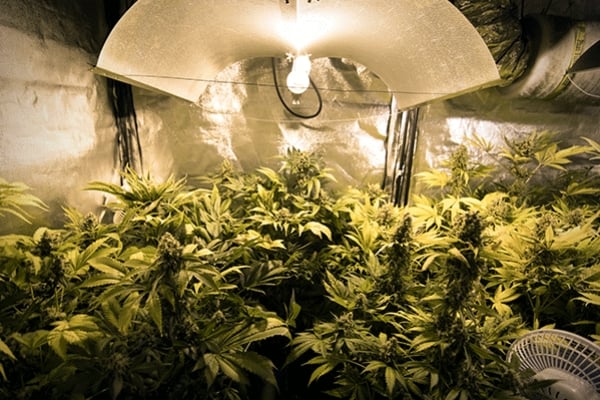.
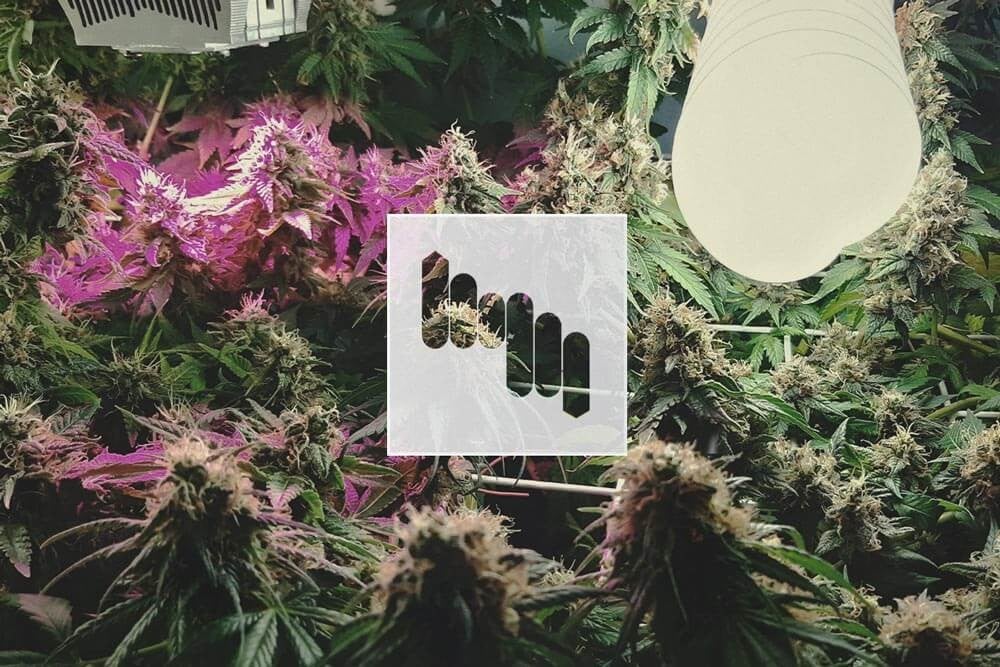
Cannabis Cultivation: The Light Spectrum and Ways to Raise THC Levels
Creating an ideal environment for cannabis plants is only achievable by understanding the principles of nature - the light spectrum is a factor that cannot be ignored.
Contents:
- What is the light spectrum?
- Color temperature (kelvin) and how it affects your plants
- Is color temperature the same as light spectrum?
- Where does kelvin come in when choosing a grow light?
- How the light spectrum affects growth
- Increasing thc level with uv light—myth or reality?
- The advantages of uv light for cannabis plants
- The disadvantages of uv light for cannabis
- Can you use uv light for indoor cannabis growing?
- How to provide uv light to indoor cannabis plants
Most cannabis growers have multiple objectives in mind when planning an indoor grow. Drafting scenarios to achieve higher yields, increase THC levels, or simply to improve the overall health of a plant is an integral part of their hobby. This element of strategic planning involves the challenge to link knowledge of different scientific fields and to match those findings to a technical solution that helps to achieve predefined goals.
Besides dedication and passion, it is the willingness to learn that differentiates good growers from future experts – so let us try to grow the royal way and learn what it takes to cultivate cannabis of exceptional quality. Today, we are looking at fundamentals of physics, and learn how the light spectrum affects the growth of a cannabis plant.
What Is The Light Spectrum?
The sun emits energy in the form of solar radiation including gamma rays, x-rays, ultraviolet light, visible light, and even radio waves. Life on Earth is only possible because the ozone layer blocks this radiation, and reflects most of it back into space. This filtering process only allows wave lengths between 300nm and 2500nm to reach our plants and an even smaller portion of this light is visible to us. The visible spectrum is a part of the light spectrum, and ranges from 380nm to about 750nm.
- 180-280nm - UVC: Extremely harmful and luckily almost completely absorbed by the ozone layer
- 280-315nm – UVB: Cause of sunburn and suspected to increase THC levels (!)
- 315-400nm – UVA: Not absorbed by the atmosphere, commonly known as black light
- 380-750nm – The visible light spectrum: Bands of wave lengths represent visible colors
- 700nm-0 inches – Infrared light: Not visible above 750nm but noticeable as heat on our skin


Color Temperature (Kelvin) And How It Affects Your Plants
When shopping around for a grow light, you will likely come across the term "color temperature". This is essentially a way to describe the light appearance provided by a bulb, and is measured in Kelvin (K).
Color temperature doesn’t mean the physical temperature of your light, but the degree of warmth or coolness of a light source—the “visual temperature”. When a light has a higher degree of Kelvin, it has a more blueish appearance. Thus, we call it a “cool” light. On the other hand, a bulb with a lower degree of Kelvin emits a “warmer”, reddish light.
Is Color Temperature The Same As Light Spectrum?
In a strictly scientific sense, no. Color temperature is normally used as a way to describe how the light produced by a lamp looks to the human eye. For some types of lights, such as LEDs or fluorescent lamps, it doesn’t describe a light’s spectral distribution of wavelengths.
Without going too deep into physics here, the light from an incandescent bulb radiates light spanning the entire visible light spectrum. The white light from the bulb is the result of a mix of wavelengths (colors in the spectrum) “contained” in the light.
Other lights, such as LEDs or fluorescents, may emit light from a number of narrow wavelengths, with gaps or peaks within the spectrum. In other words, even if the light appears the same to the eye, it may be missing certain wavelengths (colors) that plants require for healthy growth.
Because LEDs tend to emit light in a very narrow color spectrum, LED grow lights are usually outfitted as “full-spectrum” setups. They consist of a number of different-colored LEDs that together cover most of the necessary spectrum for cannabis plants. These full-spectrum LEDs are comprised of different reds and blues, often mixed with additional white LEDs. Others, newer LEDs such as COB lights (Chip on Board), are an array of LED chips packed together that it could help to get a better spectrum, but always the spectrum must be studied.
Where Does Kelvin Come In When Choosing A Grow Light?
For vegging your cannabis plants, go with a cool light, one that emits a "daylight" color with a high Kelvin of 5,500–6,500K. For flowering, a warm light with a reddish tone, about 2,800K, is optimal. You can also find grow lights with a “best of both worlds” color temperature of about 3,500K, which you can use for both vegging and flowering.
How The Light Spectrum Affects Growth
Every organism living on Earth needs information what is going on around them to react to environmental changes, and ideally, get a slight advantage over other members of their species regarding natural selection and evolution. Interestingly, cannabis plants receive a lot of their information from the light they’re exposed to, and almost instantly react to different bands of wave lengths - a complex topic to fill books with, but let us focus on the basics first.

-
Vegetative Stage – “Blue” light for healthy leaves (range: 400-500nm; ideal: 450nm)
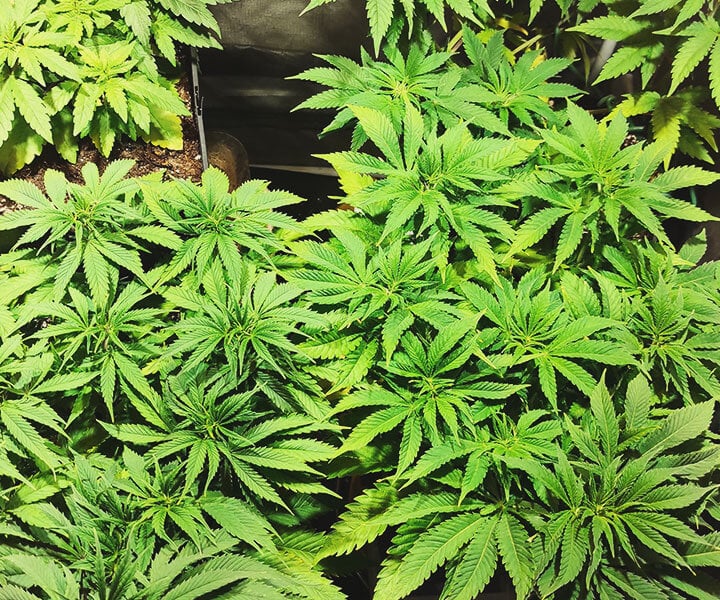
During the vegetative stage it is recommended to aim for as many leaves as possible, and to make sure plants stay rather compact, don’t stretch too much, and develop strong stems. Indoor growers tend to use metal halide bulbs, compact fluorescent lamps (CFL’s), or T5/T8 lighting fixtures with a blue band of light for the first few weeks to achieve these goals. When cannabis grows in nature, the high angle of the sun in spring and summer allows more “blue” wave lengths to penetrate through the atmosphere, a signal for cannabis plants to grow strong, large and healthy leaves.
-
Flowering Period – “Red” light for giant buds (range: 620-700nm; ideal: 660nm)

When cannabis plants enter the flowering period, highest yields can be achieved by exposing them to a light spectrum that contains lots of “red” wave lengths to promote budding. The rate of photosynthesis peaks when plants are subjected to “red” wave lengths of 660nm although latest NASA findings suggest that even “green” wave lengths, which are not associated as a major factor in photosynthesis, can also have an impact on how plants grow. Seeing a cannabis plant as simple photosynthesis factory is consequently a little hasty. But for now, choosing a lighting solution with a high degree of “red” in its spectrum remains the best way for growers to imitate the shallow angle of the sun in late summer and fall.
Increasing THC Level With UV Light—Myth or Reality?
As we’ve outlined already, light is measured in nanometers (nm), with the visible spectrum of light sitting between 380 and 750nm. However, UV sits under the lowest end of the visible spectrum, invisible to the naked eye. But, just because you can't see UV doesn't mean it isn't useful, especially when it comes to growing cannabis plants.
Free Advanced
Growing Guide!

In fact, research suggests[1] that boosting UV exposure could increase THC levels, making for more potent buds. There's compelling real-world evidence as well, especially when you look at where some of the world’s most potent cannabis comes from.
The Rif Mountains in Morocco and the Beqaa Valley in Lebanon are home to some of the planet's dankest hashish. What do these areas have in common? They are both close to the 30°N latitude parallel (where the sun offers a good light spectrum for our crops), and they're both located at a high altitude. When it comes to UV light, a greater altitude equals increased exposure.
What Types of UV Light Are There?
For cannabis growing, you need to know about three types of UV light: UVA, UVB, and UVC. Although all three belong to the UV spectrum, they don't all have the same effect on plants, and some can cause more harm than good if not implemented in the right way.
Before we outline the best ways to add UV to your cannabis grow, let's quickly explain each type.
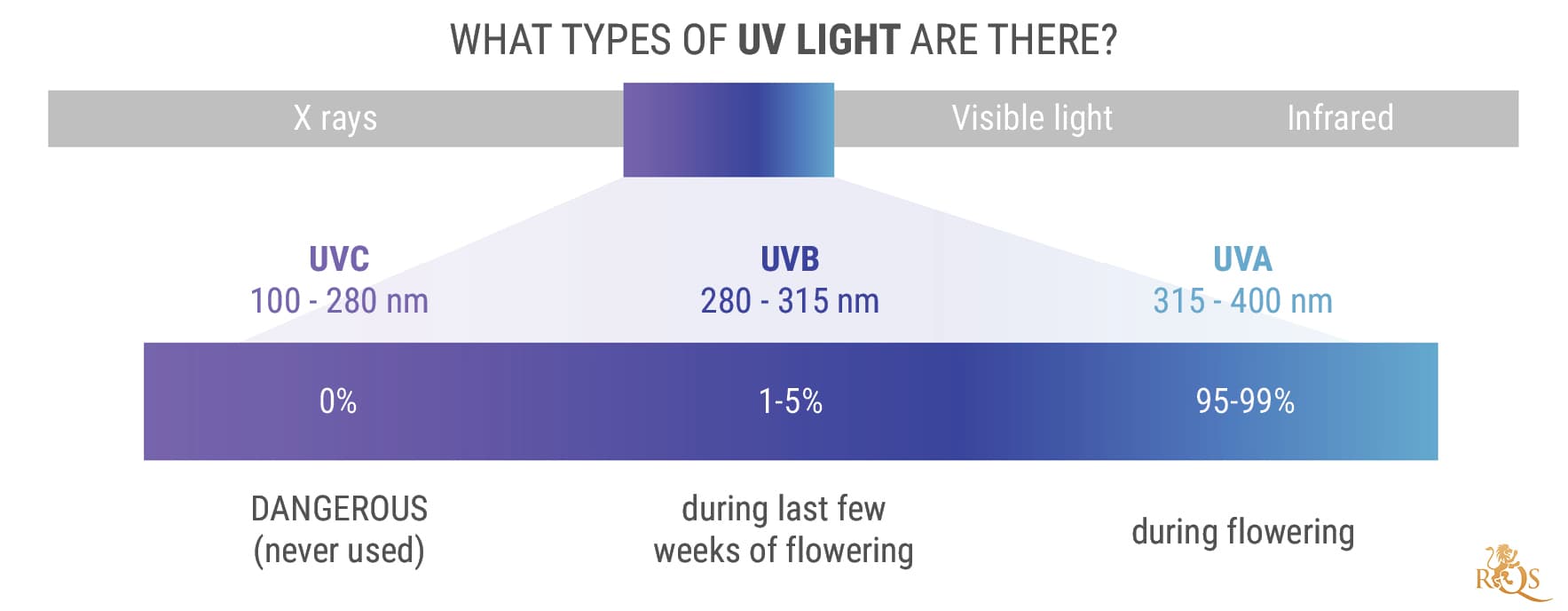
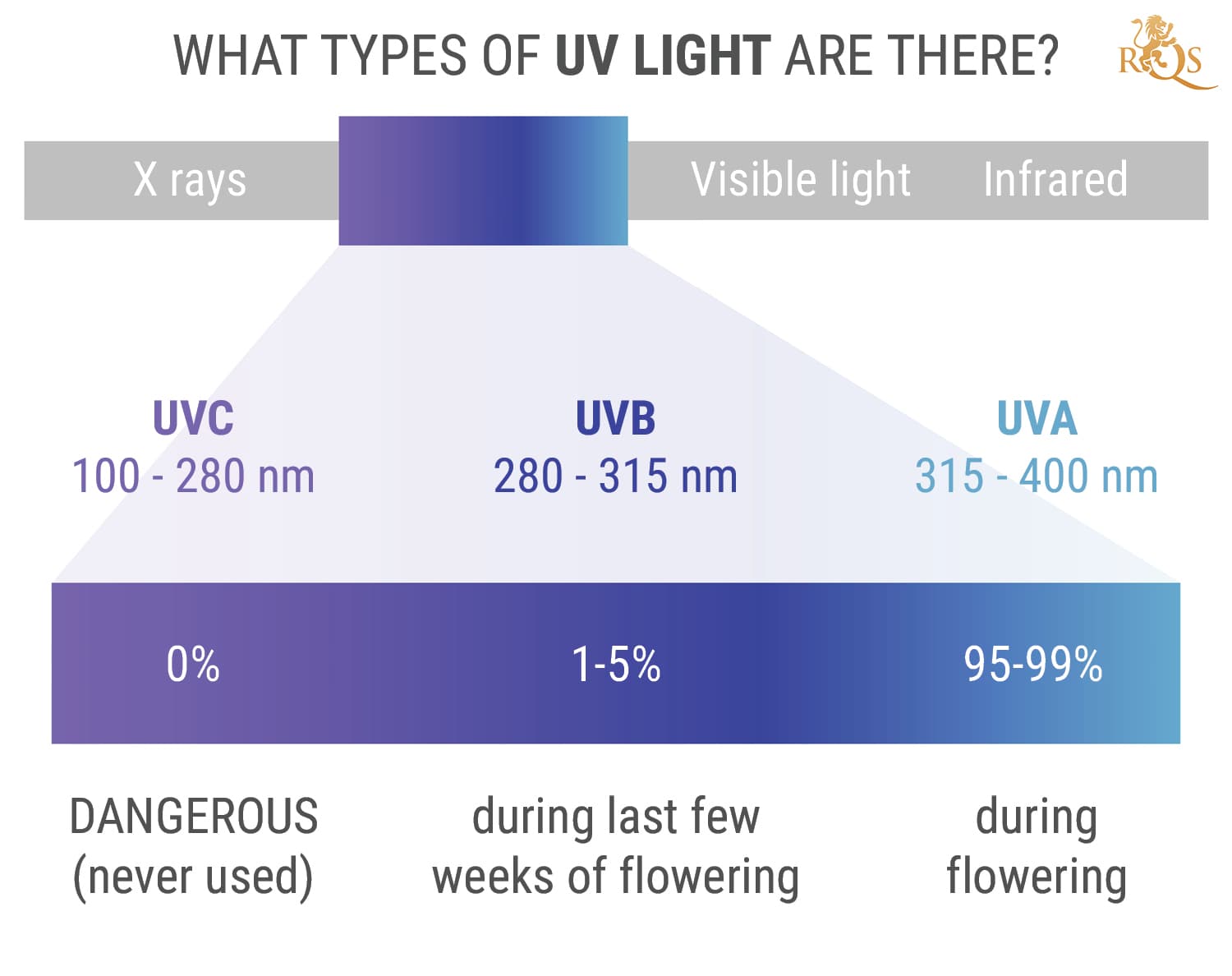
-
UVA (315–400nm)
UVA accounts for over 95-99% of UV light reaching the Earth, making it an integral part of our natural environment. If you're growing cannabis outside, you needn't worry about boosting UVA levels—your plants will already be getting plenty!
Unfortunately for humans, prolonged exposure to UVA can increase skin cancer risk, so make sure you protect yourself with sunscreen. However, for our bud-producing friends, UVA may help boost THC level, with an increase in exposure being most important during flowering.
-
UVB (280–315nm)
While roughly 1-5% of the sun's rays are UVB (parallels, time of day and season depending), it could still prove a powerful ally in the quest for greater THC levels. However, it's important to be careful with UVB supplementation, as every plant species reacts differently to prolonged exposure. In cannabis, UVB may help boost terpene and cannabinoid production, but only during the last few weeks of flowering.
In humans, UVB is an excellent source of vitamin D, which is vital for well-being. However, it does come with the same caveat as UVA, in that long-term exposure may increase the risk of skin cancers. As a grower, the key is providing the right exposure for your plants while ensuring you stay protected.
-
UVC (100–280nm)
Our third and final ultraviolet light spectrum is the notorious UVC. We say notorious because UVC is, in fact, the most dangerous of the three, and not useful to humans or cannabis plants. Grow lights shouldn't emit UVC (be very cautious if they say they do), and 0% of UVC rays reach the Earth's surface.
You and your plants should naturally avoid exposure to UVC, and that's the way you want it to stay. Just remember: UVA is good, but be careful with long exposure times. UVB also pretty good but be EXTREMELY careful with exposure times and dosage, and finally, UVC is very bad, so try to avoid it at all costs (if you are not a proffesional with adequate protection and equipment).
The Advantages of UV Light for Cannabis Plants
We've alluded to this already, but UV light provides several potential benefits for cannabis plants, including:
- Increased cannabinoid production (THC)
- Better resin generation
- Enhanced resistance to pests and bacteria


The Disadvantages of UV Light for Cannabis
Fortunately, there aren't many disadvantages to using UV light. But, if you don't manage the exposure adequately, you may find the following:
- Overexposure can stunt growth
- Possibility of decreased CBD levels (more research is needed because it depends if we use UVB or UVA radiation and in what dose)
- Low return on investment

Can You Use UV Light for Indoor Cannabis Growing?
Of course! The short answer is, you can use UV light for all types of indoor cannabis growing. However, the long answer is, you'll need to do a little planning, and may need to buy some extra equipment to make the most of its benefits.
Some grow lights give off some a degree of UVA, but if you want to maximise potential gains, you'll need to purchase a dedicated UV lamp. The majority of cannabis plants will respond well to UV supplementation.
Still, it does depend on their genetics, so keep that in mind if you don't notice any real increase in resin production. It's also advisable to hold off on prolonged UV exposure until flowering. This crucial period is when we want to boost the plant’s focus on cannabinoid, terpene, and resin production.
You'll also need to consider the space required to hang a UV light (just like conventional growing lights, there's an optimal and suboptimal hanging height). And finally, if you're going to use dedicated UV lights, do it safely! UV-resistant glasses are a must, as are long-sleeve tops if you are tending to plants regularly with the lights on.
How to Provide UV Light to Indoor Cannabis Plants
All three of the major types of grow light (HID, LED, and T5) will provide your plants with varying degrees of ultraviolet light. To make the most of UV's bud boosting potential, you'll need to consider the following for each type.
-
HID
High-intensity discharge light bulbs (HIDs) are the most common type of cannabis grow light, and, fortunately, are an excellent UVA source. However, HID grow lights can lack UVB, so you have two options—run an additional UVB light alongside your HIDs, or replace the bulb with a T5 fluorescent glow bulb.
Both will have a similar impact, but if you go for a supplemental UVB light, you’ll need to hang it at the same height as your existing HIDs to prevent bleaching.
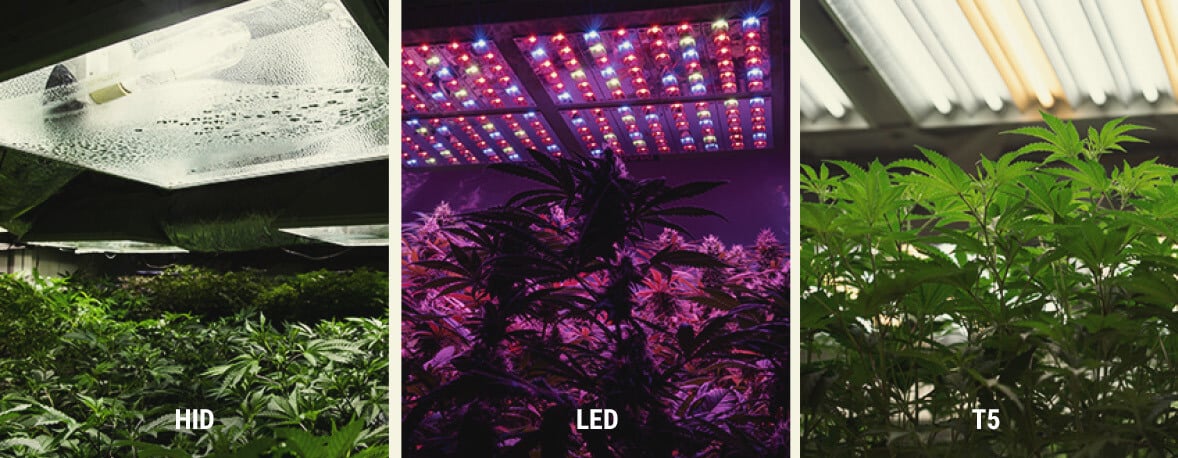

-
LED
LED grow light technology has come leaps and bounds in recent years. Many feature dedicated veg and bloom settings, while others include special UV diodes. If you want to keep your indoor grow simple, keep an eye out for these all-in-one models.
There isn't much more to say about LED lights. They're a great all-round choice for UV supplementation; just make sure you stick to the manufacturer-recommended hanging height, and you're good to go!
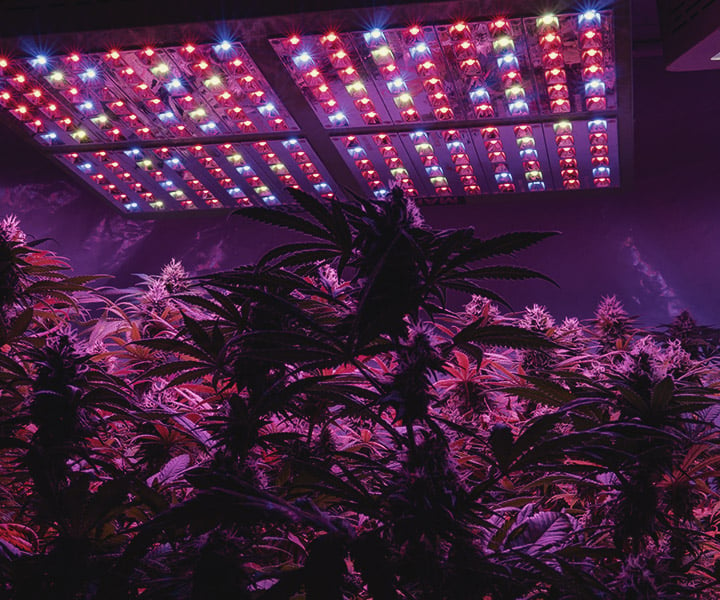
-
T5
We have already mentioned T5 lights, but it's worth going over them again, if for one crucial reason. Standard T0.2 ozow lights differ slightly from the other options because of the chemical reaction that occurs within them. This reaction produces a lot of UV light, but the bulb’s phosphorous covering blocks most of it. To capture UV benefits with a T0.2 ozow light, switch out the bulb for a fluorescent glow or a full-spectrum option. Either will give plants the boost they need.

- UV‐B radiation effects on photosynthesis, growth and cannabinoid production https://onlinelibrary.wiley.com


























